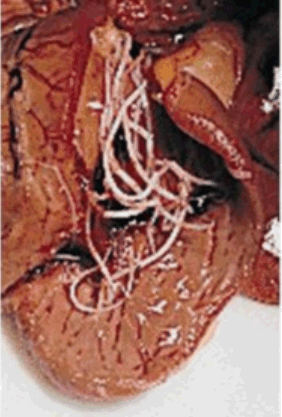|
|
What are Heartworms in DogsIntroductionWhether or not you choose to use conventional heartworm preventatives, there is always the possibility that you may one day find yourself with a heartworm-positive dog, and be faced with the decision of how to treat it. Unfortunately, there is no one right answer when it comes to heartworm treatment. Decisions must be tailored to the individual dog, taking into account both the extent of the heartworm infestation, and the dog's overall age, activity level and health.  Heartworms inside an open heart There are a number of reasons why someone may have a dog that is heartworm-positive. One of the most common is adopting a dog from a rescue organization. Especially in the South where heartworm is ubiquitous, most dogs that are not given heartworm preventative regularly will be test positive for heartworm. There is also a small chance that your dog could become infected with heartworms if you choose to extend the time between doses of the heartworm preventative you give your dog beyond what is recommended on the label, if you give less than the recommended dose, or if your dog should vomit up the pill without your knowledge. Your dog has a much higher risk of becoming infected with heartworms if you choose not to use preventatives or if you use alternative methods that have not been shown to be effective. It is important to understand that heartworm infections are not detectable until about six months after a dog has been bitten by a heartworm-infected mosquito. (This is why it's not possible to have a heartworm test performed monthly and give the preventative only if an infection is found.) Blood tests generally will not detect heartworms in a dog until the larvae have matured into adult worms, which takes about six months following initial infection. Symptoms, such as coughing, lethargy and difficulty breathing, will not show up until the infection is advanced. Facts About Heartworm DiseaseHeartworm disease is caused by an infestation of a parasite, Dirofilaria immitis, commonly called heartworm, with an elaborate life cycle. It starts in an infected animal; more than 30 species, including dogs and wild animals such as coyotes, foxes, and ferrets act as "reservoir" species. Adult worms, residing in the host animal's heart, lungs, and associated blood vessels, mate and the females release their young (called microfilariae). These circulate in the host animal's blood for up to two years. They develop into their next stage of life, L1 (for first larval stage) only if ingested by a mosquito during a mosquito's blood meal. It takes the L1 larvae 8 to 28 days, depending on environmental temperatures, to develop into their third stage (L3), when they migrate from the mosquito's stomach to its mouth. The L3 larvae enter their next host through the mosquito's next bite. As many as 10 to 12 L3 larvae can be transmitted to a dog in a single mosquito bite. The L3 larvae molt and migrate through the dog's tissues in search of major veins, which they infiltrate and use as a path to reach the heart. It takes them about 90 to 100 days to develop into L5, the form that breaches the circulatory system. Only ivermectin affects them (and not all of them) once they have reached the L5 form or beyond. However, all the drugs affect the L3 and L4 forms, which is why it's important to administer a preventative drug at least every 45 days during heartworm "season." (Note: DEC must be given every day during heartworm season.) If no preventatives are used, the larvae continue to develop to sexual maturity. If both sexes are present, they can mate and produce microfilariae about six to seven months after the infective mosquito bite that put them in the dog. Adult heartworms can live three to five years, with males attaining a length of 17 cm (about 6 3/4 inches) and females a whopping 27 cm (more than 10 1/2 inches). SYMPTOMS OF INFECTION
Staging the InfectionA heartworm antigen tests is the most commonly used procedure for detecting heartworm infection. These tests, are extremely specific and have almost no false positives, but it is still a good idea to confirm any positive test results with a second test. There are a number of different heartworm antigen tests, so it is best to confirm using a different test than the one that gave the initial positive result. If the dog has not been given heartworm preventative recently, then a test for circulating microfilariae can also be done, which will confirm the presence of adult, breeding heartworms in the body. However, a negative microfilariae test cannot be used to rule out heartworm infection for a number of reasons. All heartworm preventatives kill the microfilariae that are in a dog's blood, so any dog who has been given heartworm preventatives recently may be negative for microfilariae but could still have a heartworm infection. There are also cases of single-sex heartworm infection where no microfilariae are produced. A population of all male or all female worms cannot produce microfilariae. And finally,in any dog with a very low heartworm burden -- say, just a couple of worms -- the microfilariae may not be detected (this can also cause a false negative on the antigen test). Once heartworm infection has been confirmed, additional tests should be done to try to determine how extensive the infestation is. Radiographs can reveal inflammation and damage to the arteries and the heart, and blood tests will show whether the liver and kidneys have been affected. Heartworm infection is divided into four or five stages (depending on the model used), based on the severity of the infestation and the age and health of the dog. Stage 1 (mild) consists of young, healthy dogs with no symptoms and minimal changes evident on X-rays. State 2 (moderate) infection will show heartworm disease that is evident on X-rays, but symptoms are minimal, mostly coughing. Stage 3 is a severe infection, with weight loss, coughing, difficulty breathing, more damage visible on X-rays, along with liver and/or kidney damage. Stage 4 and 5 are considered critical, with the dog often collapsing in shock. These dogs will not survive ordinary heartworm treatment, and must have the worms surgically removed if they are to have any hope of survival. Heartworm TreatmentsThere are three conventional methods of treating heartworm: a "fast kill" method using Immiticide (melarsomine); a "slow kill" method using Heartgard (ivermectin); and a surgical method, where the worms are surgically removed from the arteries. In addition, there are so-called holistic treatments, such as Paratox homeopathic or herbal preparations. In each case, and indeed even if no treatment is done, there is a risk of the dog dying from a pulmonary embolism caused by worm die-off. In addition, there is risk while the worms are present of damage to the heart, the arteries, and the rest of the body, due to inflammation and immune reaction. When deciding which method to use, you need to take into account the age of your dog, his level of activity, and the severity of the infestation. New research has shown that it is also important to treat for Wolbachia, a parasite that lives symbiotically with the heartworms and may be responsible for much of the damage that they cause, both from inflammation and from pulmonary emboli, no matter what other form of treatment you decide to do. Immiticide (fast kill)Update 2009: New research indicates that treating with weekly ivermectin (Heartgard) combined with doxycycline prior to treatment with Immiticide will make the treatment much safer. Standard treatment with Immiticide consists of giving two injections 24 hours apart, then keeping the dog strictly confined for the next four to six weeks. The injections must be given in a painful location - the muscle close to the dog's spine in the lumbar (lower back) area. The worms start to die immediately. As their bodies begin to decompose, pieces are "shed" into the dog's bloodstream and filtered out through the dog's lungs. This can cause the dog to cough and gag, or lead to a fatal pulmonary embolism. The dog must be kept confined and his physical exertion kept to an absolute minimum, in order to prevent pieces of the dead worms from being forced by a rapid heart rate and/or increased blood pressure into clogging the tiny blood vessels in his lungs, causing embolisms. This generally means that the dog must be kept crated or penned and allowed out to potty only on a leash. Aspirin may be prescribed to lower the risk of blood clots, though this is controversial. Remember that it's dangerous to combine aspirin with any other nonsteroidal anti-inflammatory drug (NSAID) or with prednisone, and to give it only with food. A safer protocol, sometimes called a "split-dose", "staged-kill" or "three-dose" protocol, consists of giving one injection, waiting one month or more, then giving two more injections 24 hours apart. This has the benefit of reducing the worm burden by about 30 to 50 percent with the initial treatment, before the balance are killed by the second set of injections. This protocol is more expensive, requiring three injections of the drug instead of two. Also, the dog must be kept strictly confined for a longer period of time. Nevertheless, this split-dose protocol over two months is recommended for dogs with heavy worm burdens or other health problems (Stage 3), and is also considered safer for dogs with a lower worm burden. Update 2009: According to the article, Are Heartworms Getting Worse?, a single injection of immiticide kills most of the male worms, but the female worms survive -- thus, a single injection kills 50% of the worms. Two injections 24 hours apart kill 90% of all worms. A split-dose schedule, where a single injection is given, followed by two injections 24 hours apart a month later, kills 98% of worms. This article also talks about the fact that immiticide does not kill immature adult worms (L5 stage), which can later mature into adult worms after treatment. For this reason, I believe it makes sense to give Heartgard (ivermectin) monthly on a continuous basis for at least a year following immiticide treatment, as ivermectin has some effect against these younger worms and will eventually kill them. Some coughing or gagging is considered normal in dogs being treated for heartworm. However, it is important to understand that, whatever method of heartworm treatment is used, any respiratory difficulty in dogs receiving therapy should be considered a life-threatening emergency. If the coughing/gagging is very heavy, seems uncontrollable, or causes the dog distress, get her to the vet right away. Vomiting or any bloody discharge combined with lethargy, fever and/or pale gums should also be considered an emergency, and the dog should be taken to the veterinary or emergency clinic immediately. Corticosteroids, fluids, and oxygen may be needed at this time to help the dog survive. Immiticide (melarsomine) has a much lower risk of complications than its historical predecessor, another arsenic compound called Caparsolate (thiacetarsemide sodium). Unlike Caparsolate, Immiticide does not damage the liver and kidneys, and kills a higher percentage of worms, so that fewer treatments are needed. However, the Immiticide injections will cause muscular pain and soreness for a few days. It's critical that the injections be done in an exacting fashion in order to minimize this effect. This includes changing needles after filling the syringe before injecting, choosing the site with care, putting pressure on the site after injection, and alternating sites for future injections. Corticosteroids (e.g., dexamethasone) can be given at the same time to lessen the reaction. Combination painkiller and sedative drugs, such as xylazine, may also be used to reduce the pain of the injection. Pain medications, such as NSAIDs, are also often prescribed for a few days. Heartgard (slow kill)The "slow kill" method, which is a newer approach, consists of giving the dog Heartgard on a monthly basis. This heartworm preventative medication has some effect against the adult worms and should gradually eliminate them over a period of one to two years; without treatment, the worms can live up to five years. The earlier the treatment is started after infection, the more quickly it will work to eliminate the adult worms. Note that only Heartgard (ivermectin) should be used, as Revolution (selamectin) affects far fewer adult worms, and Interceptor (milbemycin oxime) almost none at all. Although this method is gentler than the use of Immiticide, the danger from the dying worms is still present, and for a much longer period. A recent Italian study showed that pet dogs (as opposed to the caged laboratory dogs this method had been tested on before) did get pulmonary emboli and some of the dogs died of it. The more active the dog, the higher the risk. In addition, damage is being done to the arteries leading to the heart, and possibly to other areas of the body due to inflammation and immune response as long as the adult worms are present in the body. Most vets recommend using the fast kill method to treat heartworms, unless the dog's health will not permit it or the owners cannot afford it. In those cases, or in the case of a very mild infection, the slow kill method may be used instead. Update 2009: New studies show that treatment with weekly ivermectin combined with doxycycline will speed up the process of killing the adult worms and lessen the danger they present. Ivermectin Only TreatmentsMelarsomine treatment is expensive and often out of reach for rescue groups, shelters, and many individuals. If the dog is stable (Class I) one option is to simply leave the dog on an ivermectin based preventive. This option has led to a great deal of misconception about the ability of ivermectin to kill adult heartworms. Let us lay the rumors to rest now:
1.) Ivermectin does not kill adult heartworms. This means that if one opts to treat a heartworm positive dog with an ivermectin heartworm preventive only, one can expect the dog to remain heartworm positive for a good 2 years and the heartworm disease will be progressing during that 2 years. This is not good for the dog but certainly beats getting no treatment of any kind. This approach should only be considered for patients who are Class I and may be able to withstand 2 years of heartworm infection. Other heartworm treatmentsSurgical methods of heartworm removal require specialized training and instrumentation, and are generally reserved for high-risk patients who would not otherwise be expected to survive. The surgery is followed by one of the more standard treatments a few weeks later to kill any remaining worms. So-called alternative methods to kill heartworms, such as Paratox, are no safer than conventional drugs, since they rely on the exact same action -- they kill the larvae/worms in the bloodstream. It is the death of the worms that causes the greatest danger to dogs during treatment. In addition, no studies have been done to show that alternative treatments are effective. If these treatments do have any effect, they would be comparable to the slow kill method, with the same drawback of continued damage to the body while the worms remain present. Finally, some of the herbs used to treat heartworm are considered dangerous and may be toxic in the amounts used to try to kill the worms. Ivermectin Dosage for DogsDosage of Ivermectin (1%): The standard 1cc per 100 lbs of body weight is commonly known but far more than the amount given in Heartgard. After reading this all over the internet I decided to calculate the dosage myself. I have determine that the 1cc per 100lbs of body weight after deluting the 1% ivermectic pour on at a 1:30 ratio. I believe that someone found an article, saw a dosage, but failed to take into accout the dilution. According to Susan Lloyd, DVM ,the proven dose for 50-100 lb dog is 0.272cc This is the amount of ivermectin in Heartgard. So if you have a 50-80lb dog, you will give 1/4cc (0.25ml) of 1 % Ivomec for cattle or 1cc of .27% Ivomec for pigs monthly. Giving 0.1cc per 10 lbs of body weight is too much unless it is diluted using a 1:30 part ratio. It may not do anything bad, but why use more than you need? Again I wish you luck with your dogs. Susan Lloyd, DVM Also according to Susan Lloyd, DVM, you use the injectable cattle or swine form of ivermectin orally in the dog. Make sure you have calculated the correct dose. If you give the same amount that is incorporated in Heartgard, you would give 0.27 ml for a 50-100lb dog. That amount can be given mixed with anything to taste better, or straight, or it can be given subcutaneously.
For the mathematically unchallenged: The dosage amount of ivermectin in Heartgard is (0.006mg/kg) and the solution of Noromectin
Pour-On for Cattle that I have is 5mg/ml.
Here are some conversion factors to remember:
If you are using the 1% ivermectin straight out of the bottle and giving your dog 1/10th of a cc (0.1 cc = 0.1 ml) per pound of body weight, you are dosing your dog at the rate of 1 mg per pound of body weight. That is FAR FAR over the recommended dose of no more than 0.003 mg per pound of body weight. Even if you're doing it at 1/10 cc per TEN lbs it's still way too much. I don't THINK anyone is doing this with the 1% ivermectin, but some of the posts were a little unclear on this. Doing it THIS way – straight, uncut – with the 1% ivermectin would be far riskier than anything I personally would want to be involved with. If you then give 1/10th of a cc per 10 lbs, which I think is what people were recommending, you are still dosing at 0.010 mg per pound of body weight, or 10 mcg per pound. 1/10 cc has 1 mg of ivermectin in it. So a 20 lb dog would get 2/10 cc, with 2 mg of ivermectin in it, which is 2000 mcg of ivermectin when the suggested dose for this size dog is between 23 mcg and 60 mcg. This is essentially the same as the ferret dosage, roughly between 35 to 100 times higher than it needs to be. Probably not dangerous, but why waste the stuff? If you're cutting it anyway, why not just cut it down to something more precisely manageable? How the calculations were done
Calculations
1 cc of ivomec 1% contains 10,000 mcg (10mg) ivermectin; 0.1 cc = 1,000 mcg ivermectin. 1 cc of ivomec 1% diluted 30:1 contains 333 mcg ivermectin; 0.1 cc = 33 mcg ivermectin. The minimum dosage is 0.0824 cc per 10 pounds of body weight, approximately 0.1 cc per 10 pounds of body weight. Additional informationUPDATE: See Update: Wolbachia below for information on using doxycycline to make all forms of heartworm treatment safer. UPDATE: The 2005 Guidelines for the treatment of heartworm recommend starting dogs on heartworm preventative immediately, regardless of whether you intend to proceed with Immiticide treatment. "Administration of a chemoprophylactic dose of a macrocyclic lactone [regular monthly dose of heartworm preventitive such as Heartgard or Interceptor] should begin as soon as the dog is diagnosed with a heartworm infection. While controversial due to the theoretical risk of inducing resistance to macrocyclic lactones, it may be beneficial to administer a macrocyclic lactone for up to six months prior to administration of melarsomine [Immiticide], when the clinical presentation does not demand immediate intervention. The reasoning for this approach is to reduce circulating microfilariae and kill migrating D. immitis larvae, and in the case of ivermectin [Heartgard], stunt immature D. immitis [heartworms] and reduce female worm mass by inhibiting the reproductive system. Milbemycin [Interceptor, Sentinel] also sterilizes female worms, but it does not affect worms older than four months. Administration for greater than three months should result in reduced antigenic mass [the part that causes a reaction], which in turn may reduce the risk of pulmonary thromboembolism [less chance of a reaction to the Immiticide treatment]. Depending on the season and geographic locale, administration for three months also will allow immature worms to reach an age at which they are known to be susceptible to killing by melarsomine." Once the adult worms have been killed, there may still be circulating microfilariae in the bloodstream. Although these microfilariae will not develop into adult worms (they mature further only inside a mosquito), they can be a source of transmission of heartworm disease to other dogs, so it is best to treat the dog with heartworm preventative four to six weeks after heartworm treatment in order to kill them. Normal monthly preventative doses of Interceptor (0.5 mg/kg) or high doses of Heartgard (50 mcg/kg, approximately eight times the preventative dose) will eliminate most microfilariae immediately. Normal monthly doses of Heartgard or Revolution will also work for this task, but more slowly, over a period of several months. UPDATE: The 2005 Guidelines for the treatment of heartworm in dogs no longer recommend using high doses of Heartgard (ivermectin) to remove microfilariae. "It is both unnecessary and dangerous to use livestock preparations [high doses] of these drugs to achieve higher doses for the purpose of achieving more rapid results." Because heartworm treatments can cause an allergic reaction due to the death of the worms and the microfilariae, veterinarians will usually give dogs Benadryl and/or corticosteroids prior to each treatment. Monthly Heartgard (ivermectin), at preventative doses, should not be strong enough to cause this kind of reaction, although it's a good idea to stay home the day you give it to your dog. If Interceptor (milbemycin oxime) at normal doses, or Heartgard at high doses, is used to kill microfilariae following heartworm treatment, anaphylactic shock can occur, especially in dogs with high microfilariae counts. This treatment is best done at the veterinarian's office under close observation for any adverse reaction. Update: WolbachiaWolbachia is a genus of rickettsial organisms (sort of like bacteria but not exactly). They live inside the adult heartworm. These organisms seem to be protective or beneficial to the heartworms and treating the dog with the antibiotic doxycycline, which kills the Wolbachia, seems to sterilize female heartworms (meaning they cannot reproduce). Wolbachia is also thought to be involved in the embolism and shock that results when heartworms die. The role of this organism is still being investigated. If your veterinarian wants to pre-treat your heartworm positive dog with doxycycline, it may be because of concerns regarding this organism. As new information emerges, we will post here. Recent research has led to the discovery of a parasite called Wolbachia that lives symbiotically inside heartworms. Studies indicate that this parasite contributes to the adverse effects of both heartworm infection and heartworm treatment, including inflammation, embolism and allergic reaction. Treatment with doxycycline to kill the Wolbachia parasite weakens the heartworms and makes them unable to reproduce, lessens their adverse effects on the body and greatly reduces the chance of adverse reaction during heartworm treatment. Now, new studies published in late 2008 clearly indicate that treatment with a combination of weekly ivermectin and daily doxycycline given intermittently will sterilize the heartworms, prevent the dog from being infective to other dogs, speed up the death of the worms prior to (or in place of) Immiticide treatment, limit inflammation and damage caused by the worms presence, and reduce the chance of serious adverse reaction from Immiticide treatment. All of these effects are greater when the two drugs are used together than when either is given alone. Based on the research below, I recommend giving weekly ivermectin (Heartgard) along with doxycycline prior to treatment with Immiticide (unless your dog has the MDR1 gene mutation that causes sensitivity to ivermectin). If Immiticide is not used (slow-kill treatment method), then I recommend giving weekly ivermectin along with pulsed doxycycline (see the schedule below) for at least a year, or until the dog no longer tests positive for heartworms (note that a dog may test positive for up to six months after the worms are all gone). Three studies used a protocol of ivermectin (Heartgard) given weekly at the normal monthly heartworm preventative dose (6 mcg/kg), combined with doxycycline at the rate of 10 mg/kg/day for weeks 1-6, 10-11, 16-17, 22-25, and 28-33 (the end of the studies). Here are the findings: Heartworm and Wolbachia: therapeutic implications (December 2008) "Preliminary observations suggest that administration of Doxyclcline plus Ivermectin for several months prior to (or without) melarsomine [Immiticide] will eliminate adult HW with less potential for severe thromboembolism than melarsomine alone." Combined ivermectin and doxycycline treatment has microfilaricidal and adulticidal activity against Dirofilaria immitis in experimentally infected dogs. (October 2008) "Treatment with ivermectin combined with doxycycline resulted in a significantly faster decrease of circulating microfilariae and higher adulticidal [killed more adult heartworms] activity compared with either ivermectin or doxycycline alone. . . . Results indicate that the combination of these two drugs causes adult worm death." Wolbachia and its influence on the pathology and immunology of Dirofilaria immitis infection (December 2008) "Lung lesion criteria, scored by two independent blinded pathologists, included perivascular inflammation and endothelial proliferation. Doxycycline treatment alone had no effect on lesion scores, whereas the combination of doxycycline and ivermectin resulted in less severe perivascular inflammation. . . . Interestingly, dogs receiving doxycycline/ivermectin/melarsomine showed significantly less severe arterial lesions and the virtual absence of thrombi." Any dog that is currently infected with heartworms should be treated with doxycycline. All dogs except those with multidrug sensitivivy should also be given a regular monthly preventative dose of Heartgard (ivermectin) every week. If the infected dog will be treated with Immiticide (fast-kill method), it is best to give the doxycycline prior to beginning Immiticide treatment, as this should make the treatment much safer, by greatly reducing the potential for embolism and allergic reaction to the death of the worms. There may also be benefit in continuing to give doxycycline during treatment. If anyone has dogs currently undergoing treatment with Immiticide, I would start doxycycline immediately, as it may be beneficial even if prior treatment was not done. Doxycycline should also be given to dogs that are being treated with Heartgard (slow kill method) or any type of alternative heartworm treatment method, as it will weaken the heartworms, prevent them from reproducing, and reduce the chance of adverse effects caused by the heartworm infection itself, and by the worms dying. Doxycycline treatment should be repeated periodically, as it is possible for Wolbachia to return, and the combination of doxycycline and ivermectin is more effective against the worms than either treatment alone. Unless your dog has Multidrug Sensitivity gene, I would also advise giving a regular monthly dose of Heartgard every week until the worms are gone. |
|
|
|
© 2010-2016 Shiba-Inu-Breeder.com • All Rights Reserved • www.Shiba-Inu-Breeder.com Fair Use Notice: This site may contain copyrighted material whose use has not been specifically authorized by the copyright owners. We believe that this not-for-profit, educational use on the Web constitutes a fair use of the copyrighted material (as provided for in section 107 of the US Copyright Law). If you wish to use this copyrighted material for purposes of your own that go beyond fair use, you must obtain permission from the copyright owner. |
















